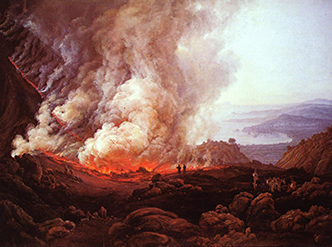Unveiling Volcano Secrets: The Role of Cosmic Rays in Volcanic Research
In a groundbreaking exploration, scientists are harnessing cosmic rays to uncover the hidden secrets of volcanoes. This innovative approach, known as muography, utilizes the subatomic particles generated by cosmic rays to map the internal structures of volcanoes, providing insights into their behavior and potential eruptions.

The Cosmic Rainstorm
Every second, Earth is bombarded by trillions of cosmic rays, which collide with atmospheric gases, creating muons—subatomic particles that are more than 200 times heavier than electrons. These muons travel through the atmosphere and, upon encountering solid objects, some pass through while others are absorbed. This unique interaction allows researchers to visualize the inner workings of structures that are otherwise inaccessible, including the complex anatomy of volcanoes.
Mapping Volcanoes with Muons
A recent study published in the Proceedings of the Royal Society A highlights the successful application of muography in mapping the internal features of volcanoes worldwide. Lead researcher Giovani Leone from the University of Atakama in Chile suggests that this technique could revolutionize volcanic monitoring by tracking the movement of molten rock in real-time, potentially forecasting eruptions.
Muons lose energy as they pass through dense materials, making it possible to differentiate between solid rock and voids within a volcano. By placing muon detectors around a volcano, researchers can create two-dimensional images of its structure, similar to X-ray imaging in medicine. With multiple detectors, a three-dimensional reconstruction of the volcano's interior can be achieved, revealing critical information about magma chambers and potential eruption pathways.
Success Stories and Applications
The technique has already been applied to several active volcanoes, including Japan's Mount Asama and Italy's Mount Etna. In these cases, muography has revealed hidden features such as buried lava mounds and pathways that could facilitate future eruptions. Moreover, muons have identified areas of potential weakness in volcanic structures, assisting in the assessment of landslide risks and lava escape routes.
Limitations and Future Prospects
Despite its promise, muography has limitations. The technique primarily examines sections of the volcano that the muons can penetrate, leaving deeper regions largely unexplored. Experts like Marina Rosas Carbajal emphasize that while muography is a valuable tool, it cannot replace existing volcanic monitoring methods such as seismic surveys and satellite imagery.
Future research will focus on deploying muon detectors at more volcanoes and improving the precision of the technique through laboratory experiments. While muography may not eliminate the unpredictability of volcanic eruptions, it represents a significant advancement in our understanding of these complex geological phenomena.
Conclusion
The intersection of particle physics and volcanology highlights the potential of cosmic rays to enhance our understanding of volcanoes. As researchers continue to refine muography, the insights gained could play a crucial role in predicting volcanic activity and safeguarding communities. This innovative approach underscores the importance of interdisciplinary collaboration in tackling the mysteries of our planet's dynamic systems.
Stay tuned for more exciting developments in the world of science and technology!
What's Your Reaction?
















